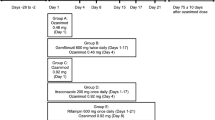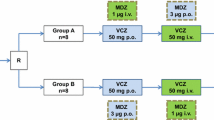Abstract
The effect of fluconazole, an antimycotic that inhibits cytochrome P-450-mediated drug metabolism, on theophylline kinetics and the production of its metabolites were compared with those of enoxacin in 5 healthy subjects. All subjects received a single oral dose of 240 mg theophylline (aminophylline, 300 mg) after they had been given oral fluconazole 100 mg every 12 h or enoxacin 200 mg every 8 h for three consecutive days.
Pretreatment with enoxacin decreased the total clearance (CLT) and elimination rate constant (Kel) of theophylline by 50% and 46%, respectively, without changing the volume of distribution (Vd), but there were no significant change in any pharmacokinetic parameter when fluconazole was administered. Enoxacin led to a 50% reduction in the metabolic clearance (CLM) of theophylline and to decreases of 69%, 59% and 38% in the formation clearance of the three theophylline metabolites, 3-methylxanthine (3-MX), 1-methyluric acid (1-MU), and 1,3-dimethyluric acid (1,3-DMU), respectively, accompanied by significant changes in the urinary recovery of theophylline and its metabolites. In contrast, treatment with fluconazole led only to a slight decrease in the CLM of theophylline (16%) and in the formation clearance of its metabolites (15%–18%), and there was no change in the renal clearance (CLR) of theophylline.
The results indicate that fluconazole is a minor inhibitor of theophylline disposition compared with enoxacin, and they suggest that the inhibitory action of fluconazole is selective for certain cytochrome P-450 isozymes, but not for the cytochrome P-4501A involved in theophylline metabolism.
Similar content being viewed by others
References
Dismukes W (1988) Azole antifungal drugs; old and new. Ann Intern Med 109: 177–179
Grant SM, Clissold SP (1990) Fluconazole. A review of its pharmacodynamic and pharmacokinetic properties, and therapeutic potential in superficial and systemic mycoses. Drugs 39: 877–916
Kowalsky SF, Dixon DM (1991) Fluconazole: a new antifungal agent. Clin Pharm 10: 179–194
Yamaguchi H, Uchida K, Kawasaki K, Matsunaga T (1989) In vitro activity of fluconazole, a novel bistriazole antifungal agent. Jpn J Antibiot 42: 1–16
Lazar JD, Wilner KD (1990) Drug interactions with fluconazole. Rev Inf Dis 12: s327-s333
Canafax DM, Graves NM, Hilligoss BC, Gardner MJ, Matas AJ (1991) Increased cyclosporine levels as a result of simultaneous fluconazole and cyclosporine therapy in renal transplant recipients: double blind, randomized pharmacokinetic and safety study. Transplant Proc 23: 1041–1042
Blum RA, Wilton JH, Hilligoss DM, Gardner MJ, Henry EB, Harrison NJ, Schentag JJ (1991) Effect of fluconazole on the disposition of phenytoin. Clin Pharmacol Ther 49: 420–425
Touchette MA, Chandrasekar PH, Milad MA, Edwards DJ (1992) Contrasting effects of fluconazole and ketoconazole on phenytoin and testosterone disposition in man. Br J Clin Pharmacol 34: 75–78
Morita K, Konishi H, Shimakawa H (1992) Fluconazole: a potent inhibitor of cytochrome P-450-dependent drug-metabolism in mice and humans in vivo. Comparative study with ketoconazole. Chem Pharm Bull 40: 1247–1251
Hunt SN, Jusko WJ, Yurchak AM (1976) Effect of smoking on theophylline disposition. Clin Pharmacol Ther 19: 546–551
Sarkar MA, Hunt C, Guzelian PS, Karnes HT (1992) Characterization of human liver cytochrome P-450 involved in theophylline metabolism. Drug Metabol Dispos 20: 31–37
Beckmann J, Elsäßer W, Gundert-Remy U, Hertrampf R (1987) Enoxacin a potent inhibitor of theophylline metabolism. Eur J Clin Pharmacol 33: 227–230
Sano M, Kawakatsu K, Ohkita C, Yamamoto I, Takeyama M, Yamashina H, Goto M (1988) Effects of enoxacin, ofloxacin and norfloxacin on theophylline disposition in humans. Eur J Clin Pharmacol 35: 161–165
Muir KT, Jonkman JHG, Tang D-S, Kunitani M, Riegelman S (1980) Simultaneous determination of theophylline and its major metabolites in urine by reversed-phase ion-pair high-performance liquid chromatography. J Chromatogr 221: 85–95
Yamaoka K, Tanigawara Y, Nakagawa T, Uno T (1981) A pharmacokinetic analysis program (MULTI) for microcomputer. J Pharmacobio-Dyn 4: 879–885
Ogilvie RI (1978) Clinical Pharmacokinetics of theophylline. Clin Pharmacokinet 3: 267–293
Ohnhaus EE, Park BK (1979) Measurement of urinary 6-β-hydroxycortisol excretion as an in vivo parameter in the clinical assessment of the microsomal enzyme-inducing capacity of antipyrine, phenobarbitone and rifampicin. Eur J Clin Pharmacol 15: 139–145
Park BK, Breckenridge AM (1981) Clinical implication of enzyme induction and enzyme inhibition. Clin Pharmacokinet 6: 1–24
Shibata K, Saito A, Miyahara T (1989) Pharmacokinetic evaluation of fluconazole in healthy volunteers. Jpn J Antibiol 42: 17–30
Vestal RE, Cusack BJ, Mercer GD, Dawson GW, Park BK (1987) Aging and drug interactions. I. Effect of cimetidine and smoking on the oxidation of theophylline and cortisol in healthy men. J Pharmacol Exp Ther 241: 488–500
Shimada T (1992) Human liver cytochrome P-450 enzymes and their implications to oxidation of drugs, toxic chemicals and carcinogens. Jpn J Toxicol Environ Health 38: 209–227
Author information
Authors and Affiliations
Rights and permissions
About this article
Cite this article
Konishi, H., Morita, K. & Yamaji, A. Effect of fluconazole on theophylline disposition in humans. Eur J Clin Pharmacol 46, 309–312 (1994). https://doi.org/10.1007/BF00194397
Received:
Accepted:
Issue Date:
DOI: https://doi.org/10.1007/BF00194397




